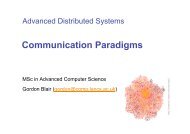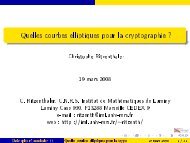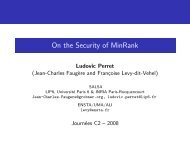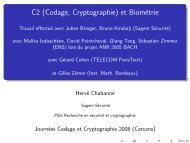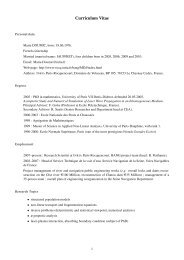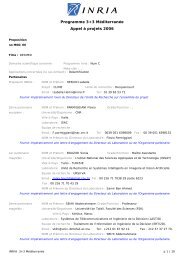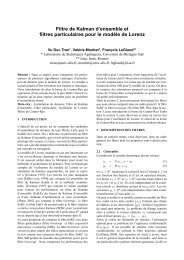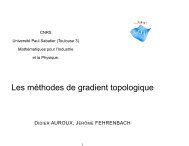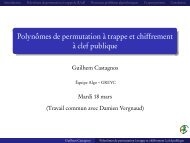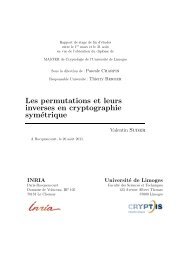Introduction à la commande stochastique v.0.9 - Jean-Pierre ...
Introduction à la commande stochastique v.0.9 - Jean-Pierre ...
Introduction à la commande stochastique v.0.9 - Jean-Pierre ...
You also want an ePaper? Increase the reach of your titles
YUMPU automatically turns print PDFs into web optimized ePapers that Google loves.
160 8. PROBLÈMES<br />
mais on a<br />
∫ ∞<br />
0<br />
| ¨ f | 2 (t)dt =<br />
∫ +∞<br />
0<br />
[ ff (4) ](t)dt .<br />
Mais par l’inégalité de Cauchy-Schwarz on a :<br />
{<br />
∫ +∞<br />
0<br />
De même on a :<br />
[ ff (4) ](t)dt} 2 ≤‖f ‖ 2 L 2 ‖ f (4) ‖ 2 L 2 ≤ k(J ( f )) 2 .<br />
∫ +∞<br />
0<br />
| ˙ f | 2 (t)dt =−<br />
∫ +∞<br />
0<br />
[ f ¨ f ](t)dt .<br />
D’où <strong>la</strong> deuxième majoration en utilisant l’inégalité de Cauchy-Schwarz.<br />
Le même genre de raisonnement pour <strong>la</strong> troisième estimation<br />
montre le résultat.<br />
2. Soit <strong>la</strong> fonction w(z 0 , z 1 , z 2 , z 3 ) solution de l’équation de <strong>la</strong> programmation<br />
dynamique<br />
∂w<br />
∂z 0<br />
z 1 + ∂w<br />
∂z 1<br />
z 2 + ∂w<br />
∂z 2<br />
z 3 − 1 2<br />
( ∂w<br />
∂z 3<br />
) 2<br />
+ γ 2 z2 0 = 0 ,<br />
w(0, 0, 0, 0) = 0 ,<br />
et soit v une <strong>commande</strong> admissible, c.<strong>à</strong>.d. telle que z ∈<br />
H (4) (0, ∞; R), on a alors<br />
d<br />
∂w<br />
w(Z(t)) = [ ż + ∂w ¨z + ∂w z (3) + ∂w v](t)<br />
dt ∂z 0 ∂z 1 ∂z 2 ∂z 3<br />
≥− 1 2 (v2 + γ z 2 )(t) .<br />
Cette dernière inégalité provientdel’équation dynamique en se rappel<strong>la</strong>nt<br />
que<br />
− 1 ( ) 2 ∂w<br />
≤ ∂w v + v2<br />
2 ∂z 3 ∂z 3 2 .<br />
On obtient alors :<br />
∫ ∞<br />
1<br />
w(Z(∞)) − w(Z(0)) ≥−<br />
0 2 (v2 + γ z 2 )(t)dt .<br />
Et donc w(Z(0)) ≤ ∫ ∞ 1<br />
0 2 (v2 + γ z 2 )(t)dt puisque <strong>la</strong> trajectoire Z<br />
est nulle <strong>à</strong> l’infini. Si on avait pris pour v <strong>la</strong> <strong>commande</strong> optimale on<br />
aurait obtenu une égalité.<br />
Enfin si Z(0) = (0, 0, 0, 0) <strong>la</strong> <strong>commande</strong> v = 0 conduit <strong>à</strong>un<br />
coût nul et donc w(0, 0, 0, 0) = 0.<br />
EQUATION DE RICCATI ALGÉBRIQUE.<br />
1. On cherche une solution de <strong>la</strong> forme w(ζ) = (1/2)ζ ′ Pζ. La matrice<br />
P doit vérifier alors l’équation de Riccati algébrique :<br />
A ′ P + PA− PB ′ BP + γ C ′ C = 0 ,



